
Venkateswara is a form of the Hindu god Vishnu and is the presiding deity of the Venkateswara Temple, located in Tirupati, Andhra Pradesh, India. Venkateswara is also known by various other names.

Guruvayurappan also often rendered Guruvayoorappan. is a form of Vishnu worshipped mainly in Kerala. He is the presiding deity of the temple, who is worshipped as Krishna. Even though the deity is that of chaturbahu Vishnu, the sankalpam (concept) of the people is that the deity is Krishna, that too mainly in his infant form. This form of lord Vishnu is very pleasant.
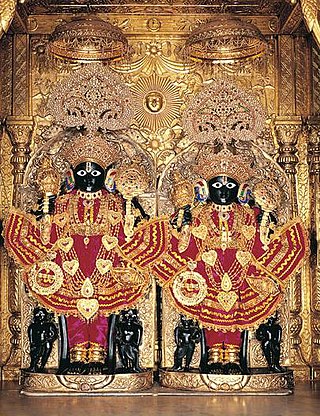
Naranarayana, also rendered Nara-Narayana, is a Hindu duo of sage-brothers. Generally regarded to be the partial-incarnation (aṃśa-avatara) of the preserver deity, Vishnu, on earth, Nara-Narayana are described to be the sons of Dharma and Ahimsa.
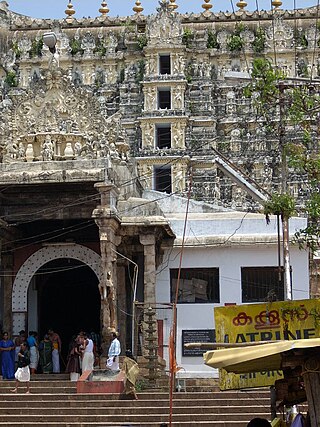
The Shree Padmanabhaswamy Temple is a Hindu temple, dedicated to Maha Vishnu, in Thiruvananthapuram, the capital of the state of Kerala, India. It is widely considered as the world's richest Hindu temple. The name of the city of 'Thiruvananthapuram' in Malayalam and Tamil translates to "The City of Ananta". The temple is built in an intricate fusion of the Kerala style and the Dravidian style of architecture, featuring high walls, and a 16th-century gopura. While as per some traditions the Ananthapura temple in Kumbla in Kasaragod district in Kerala is considered as the original spiritual seat of the deity ("Moolasthanam"), architecturally to some extent, the temple is a replica of the Adikesava Perumal temple in Thiruvattar in Kanyakumari district in Tamil Nadu.

The Adikesava Perumal Temple is a Hindu temple located in Thiruvattar, Kanyakumari district, Tamil Nadu, India and is one of the 108 Divya desams, the holy sites of Hindu Vaishnavism according to existing Tamil hymns from the seventh and eighth centuries C.E. The temple is one of the historic thirteen Divya Deshams of Malai Nadu. The temple is a picturesque setting surrounded on three sides by rivers namely, It was the Rajya Temple and Bharadevatha shrine of Erstwhile Travancore. After state reorganisation, the temple handed over to Tamilnadu H&RCE Dept. The presiding Vishnu in the form of Ananthapadmabhan/Adikeshavaperumal is believed to be older than Padmanabhaswamy Temple in Thiruvananthapuram. Since Vishnu resides here in a reclining position, and is surrounded by rivers, the temple is called as "The Srirangam of Chera Kingdom".

The Champakulam Moolam Boat Race is one of the oldest vallam kali in Kerala state of south India. The race is held on the River Pamba on Moolam day of the Malayalam month Midhunam, the day of the installation of the deity at the Ambalappuzha Sree Krishna Temple.
Odanad was a feudal state in late medieval Kerala. It was established in the 11th century, and disestablished in 1746 when it became part of Travancore after Venad King Marthanda Varma's northern expedition. The last king of Odanad was King Kotha Varma. At the time of its dissolution, it was composed of the present-day taluks of Mavelikkara, Karthikapally, Chenganur in the Alappuzha district and Karunagapally in the Kollam district. In the 15th century, the capital of Odanad was moved from Kandiyoor-Muttom, Mavelikkara to Eruva and Krishnapuram, near Kayamkulam, which led to the state being called Kayamkulam. After this shift, Kayamkulam became the commercial centre of Odanad, while Mavelikkara remained its cultural centre. Odanad was controlled by Nair lords, among whom the ruler of Kayamkulam was the most prominent.
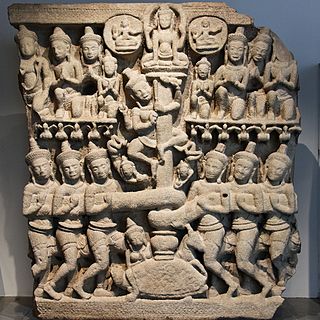
Hindu mythological wars are the wars described in the Hindu texts of ancient India. These wars depicted both mortals of great prowess as well as deities and supernatural beings, often wielding supernatural weapons of great power. Hindu teachings prescribe war as the final option, to be employed only after all peaceful methods are exhausted. Participation in righteous war, or dharmayuddha, was said to be honourable and was a principal duty of the Kshatriya or the warrior varna, and victory in such wars was regarded as a matter of honour.

Kaumodaki is the gadā (mace) of the Hindu deity Vishnu. Vishnu is often depicted holding the Kaumodaki in one of his four hands; his other attributes are the chakra, the conch, and the lotus. The gada is also found in the iconography of some of Vishnu's avatars.
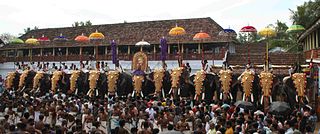
Sree Poornathrayesa temple is a Hindu temple situated in Tripunithura, Kochi, the capital of the former Kingdom of Cochin, Kerala, India. The temple is considered among the greatest temples in Kerala and was the first among eight royal temples of the erstwhile Kochi Kingdom. The deity was also considered the national deity of Cochin and protector guardian of Tripunithura. The deity in this temple is Lord Vishnu, who is in the form of Santhanagopala Murthy. Lord Poornathrayeesa is known for his love of elephants. Hence more than 40 elephants participate in his Vrishchikotsavam. And most of the elephants are sent for the utsavam (festival) without a money return expected by the elephant owners as Poornathrayeesa is considered to be an elephant lover.

The Sudarshana Chakra is a divine discus, attributed to Vishnu in the Hindu scriptures. The Sudarshana Chakra is generally portrayed on the right rear hand of the four hands of Vishnu, who also holds the Panchajanya (conch), the Kaumodaki (mace), and the Padma (lotus).
The Khandava Forest or Khandava Vana or Khandavaprastha is a forest mentioned in the epic Mahābhārata. It lay to the west of Yamuna river. The Pandavas are described to have cleared this forest to construct their capital city called Indraprastha. This forest was earlier inhabited by Naga tribes led by a king named Takṣaka.

Anandavalleeswaram Sri Mahadevar Temple in Kollam city is one of the ancient Hindu temples in Kerala, India. Lord Siva and Goddess Anandavally are the main deities of the temple. According to folklore, sage Parashurama has installed the idol of Lord Shiva. The temple is a part of the 108 famous Shiva temples in Kerala. It is located at Anandavalleeswaram, a major neighborhood of Kollam city, that comes to the west side of Kollam Collectorate.

The Sreevallabha Temple is a highly orthodox Hindu temple dedicated to Sreevallabha, a form of Vishnu. It is one of the oldest and biggest Temples of Kerala and has been a major destination for devotees all over India for centuries. Located in Thiruvalla city, this temple is well known for its architectural grandeur and unique customs which can be found in no other temples. There are stone-wooden carvings and mural paintings inside the temple. Being one among 108 Divya Desams, Sreevallabha temple has been glorified by Alvars and many other ancient works. It is considered to be the vallabha kshethram mentioned in Garuda Purana and Matsya Purana.Kathakali is played daily in the temple as an offering, pushing it to the top in India in terms of places where Kathakali is staged on the largest number of days per year. Vishnu appeared here as Sreevallabha for sage Durvasa and Khandakarnan. Pleased by the prayers of an old Brahmin lady Sreevallabha incarnated as a Brahmachari and killed the demon Thokalaasuran. Later the deity of Sreevallabha worshipped by Lakshmi and Krishna has been installed in the temple in 59 BC. From then till date, the temple follows its worship protocol that is known to be followed nowhere else yet. Sage Durvasa and Saptarishiare said to reach the temple every midnight for worshipping the Lord. The temple governed one of the biggest educational institutions in ancient times and heavily contributed to the cultural and educational developments of Kerala
Koulutla Chenna Kesava Temple is located in a reserved forest of Kappatralla, 50 km from district Kurnool District headquarters. The great Vijayanagara King, Sri Krishna Deva Raya, constructed a temple complex for the deity. Along with Koulutla Chena Kesava Temple there are additional Shiva temples in this shrine.
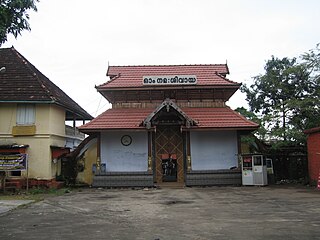
Ernakulam Shiva Temple, also known as Ernakulathappan Temple is one of the major temples of Kerala, located in heart of Ernakulam, Kochi,Kerala, India. The temple, dedicated to Lord Shiva, is considered as the city temple, with the presiding deity as the protector of the city, as per local Hindu faiths and traditions. As per the common practice in Kerala, the deity is reverently called Ernakulathappan, which means Lord of Ernakulam. The temple is located within the Durbar Hall Ground. The temple history itself has deep association with history of the city and was one of the 7 royal temples of Kochi Maharajas. The temple is now under administration of Cochin Devaswam Board. The temple in its current form was built under active patronage of Diwan Sri Edakkunni Sankara Warrier in year 1846 and raised it level of a Royal temple in the Kochi Kingdom. The temple is built on 1-acre (4,000 m2) land. The temple is one of the major Shiva temples in Kerala counted along with the Ettumanoor Mahadevar Temple, Kaduthruthy Mahadeva Temple, Vaikom Temple, Chengannur Mahadeva Temple, Vadakkunathan temple, and Sreekanteswaram Mahadeva Temple, Thiruvananthapuram.
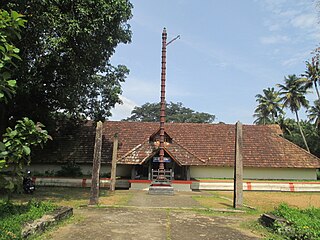
The Thrichittatt Mahavishnu Temple is a Hindu temple dedicated to Vishnu,located in Chengannur, Alappuzha District, Kerala, South India. Constructed in the Kerala style of architecture, the temple is glorified in the Nalayira Divya Prabandham, by Nammalvar, one of the Sri Vaishnava saint-poets of the 8th century called the Alvars. It is one of the 108 Divya Desams dedicated to Krishna, an avatar of Vishnu, who is worshipped as Imayavarappan. The nearest railway station to the temple is located in Chengannur, while the nearest airports are Trivandrum International Airport and Nedupumpassery Airport Ernakulam.

The Sree Subrahmanya Swamy Temple (Perumthrikkovil), also known as Kerala Palani or Dakshina Palani (lit. 'Southern Palani'), in Haripad, Kerala, is one of the oldest and largest temples in the region. According to belief, the temple predates the beginning of Kali Yuga. This temple holds the distinction of being the largest Subrahmanya Swami Temple in Kerala, and features the longest golden flagpost, known as the dhwajastambha (kodimaram in Malayalam). The temple's main deity is believed to embody not only Subrahmanya Swamy but also Lord Shiva and Lord Vishnu, making it a highly revered and powerful place of worship.
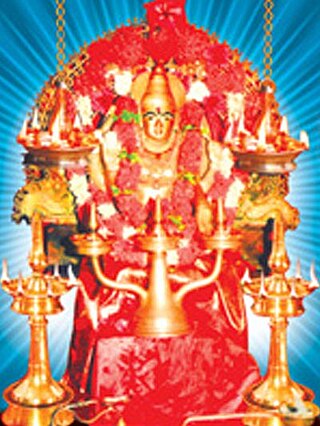
Manakkattu Devi Temple is a temple in Kerala. The temple is located at Pallippad in Karthikappalli taluk of Alappuzha district in the south Indian state Kerala. It is situated about 4 km east of Harippad on Nangiarkulangara Mavelikkara road. It comes under four NSS Karayogams
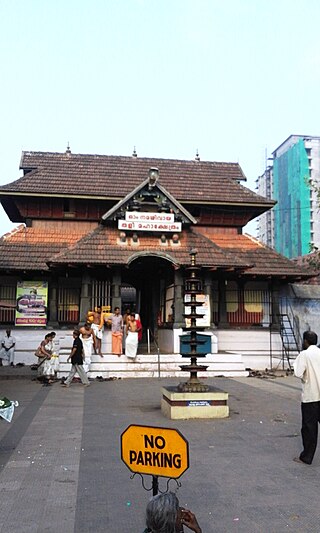
Tali Shiva Temple or Tali Mahakshetram is a Hindu temple dedicated to the deity Shiva, situated in the heart of the Kozhikode city, Kerala. The temple was built in the 14th century by Zamorin of Calicut. Tali Kshetram is an ancient temple in the heart of Kozhikode town. Shiva is the presiding deity. The Jyothirlingam in the Sanctum Sanctorum is believed to have been installed by Parasuraman. The temple is one km to the east of Kozhikode railway station. It is surrounded by the Palayam market. This was the family temple of the Zamorins who had ruled Kozhikode. Although the temple is now under Malabar Devaswom, the Zamorin is the managing trustee. The temple is built in traditional Kerala architectural style. The two-storied sanctum-sanctorum is in the shape of a chariot. It is adorned with murals and granite sculptures of Shiva’s retinue. Inside Sree Kovil deities of Tali Ganapathy, Thevarathil Ganapathy and Thrumandhakunnu Bhagavathy are installed. Sree Krishna, Thevarathil Bhagavathy, Ayyappa, Sri Vishnu and Nagam are installed outside Shiva Temple. Sree Valayanad Bhagavati idol is installed inside Sree Krishna Temple. There is a small Narasimha Moorthy temple on the southern side of the Sri Vishnu Temple.


















